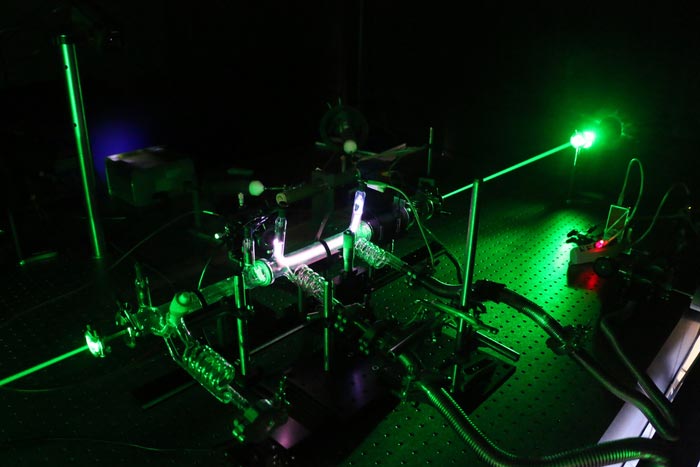Harvesting resources on Mars with plasmas

Carbon dioxide plasma created at the Laboratoire de Physique des Plasmas, Ecole Polytechnique in France and used in the research on harnessing and processing local resources to generate products on Mars.
Credit: Olivier Guaitella
A plasma-based method may one day convert carbon dioxide into oxygen and produce fuels, fertilizers on the red planet.
An international team of researchers came up with a plasma-based way to produce and separate oxygen within the Martian environment. It’s a complementary approach to NASA’s Mars Oxygen In-Situ Resource Utilization Experiment, and it may deliver high rates of molecule production per kilogram of instrumentation sent to space.
Such a system could play a critical role in the development of life-support systems on Mars and the feedstock and base chemicals necessary for processing fuels, building materials, and fertilizers.
In the Journal of Applied Physics, from AIP Publishing, the team from the University of Lisbon, the Massachusetts Institute of Technology, Sorbonne University, Eindhoven University of Technology, and the Dutch Institute for Fundamental Energy Research presented a method for harnessing and processing local resources to generate products on Mars. Natural conditions on the red planet are nearly ideal for in situ resource utilization by plasmas, since the atmosphere is primarily formed by carbon dioxide that can be split to produce oxygen and its pressure is favorable for plasma ignition.
Two big hurdles stand in the way of producing oxygen on Mars.
“First, the decomposition of carbon dioxide molecules to extract oxygen. It’s a very difficult molecule to break,” said author Vasco Guerra, of the University of Lisbon. “Second, the separation of the produced oxygen from a gas mixture that also contains, for example, carbon dioxide and carbon monoxide. We’re looking at these two steps in a holistic way to solve both challenges at the same time. This is where plasmas can help.”
Plasma is the fourth natural state of matter, and it contains free charged particles, such as electrons and ions. Electrons are light and easily accelerated up to very high energies with electric fields.
“When bulletlike electrons collide with a carbon dioxide molecule, they can directly decompose it or transfer energy to make it vibrate,” Guerra said. “This energy can be channeled, to a large extent, into carbon dioxide decomposition. Together with our colleagues in France and the Netherlands, we experimentally demonstrated the validity of these theories. Moreover, the heat generated in the plasma is also beneficial for the separation of oxygen.”
Oxygen is key to creating a breathable environment, as well as the starting point to produce fuels and fertilizers for future Martian agriculture. Local production of fuels will be important for future missions. All are essential for future human settlement on Mars.
By dissociating carbon dioxide molecules to produce green fuels and recycle chemicals, the plasma technology may also aid in addressing climate change on Earth.
The article “Plasmas for in-situ resource utilization on Mars: Fuels, life support, and agriculture” is authored by V. Guerra, T. Silva, N. Pinãho, Olivier Guaitella, Carmen Guerra-Garcia, Floran Peeters, Mihailis Tsampas, and Mauritius C.M. van de Sanden. The article will appear in the Journal of Applied Physics on August 16, 2022 (DOI: 10.1063/5.0098011). After that date, it can be accessed at https://aip.scitation.org/doi/10.1063/5.0098011.
ABOUT THE JOURNAL
The Journal of Applied Physics is an influential international journal publishing significant new experimental and theoretical results in all areas of applied physics. See https://aip.scitation.org/journal/jap.
DOI: 10.1063/5.0098011
Article Title: Plasmas for in-situ resource utilization on Mars: Fuels, life support, and agriculture
Article Publication Date: 16-Aug-2022
Media Contact
Wendy Beatty
American Institute of Physics
media@aip.org
Office: 301.209.3090
All latest news from the category: Physics and Astronomy
This area deals with the fundamental laws and building blocks of nature and how they interact, the properties and the behavior of matter, and research into space and time and their structures.
innovations-report provides in-depth reports and articles on subjects such as astrophysics, laser technologies, nuclear, quantum, particle and solid-state physics, nanotechnologies, planetary research and findings (Mars, Venus) and developments related to the Hubble Telescope.
Newest articles

Largest magnetic anisotropy of a molecule measured at BESSY II
At the Berlin synchrotron radiation source BESSY II, the largest magnetic anisotropy of a single molecule ever measured experimentally has been determined. The larger this anisotropy is, the better a…

Breaking boundaries: Researchers isolate quantum coherence in classical light systems
LSU quantum researchers uncover hidden quantum behaviors within classical light, which could make quantum technologies robust. Understanding the boundary between classical and quantum physics has long been a central question…

MRI-first strategy for prostate cancer detection proves to be safe
Active monitoring is a sufficiently safe option when prostate MRI findings are negative. There are several strategies for the early detection of prostate cancer. The first step is often a…



